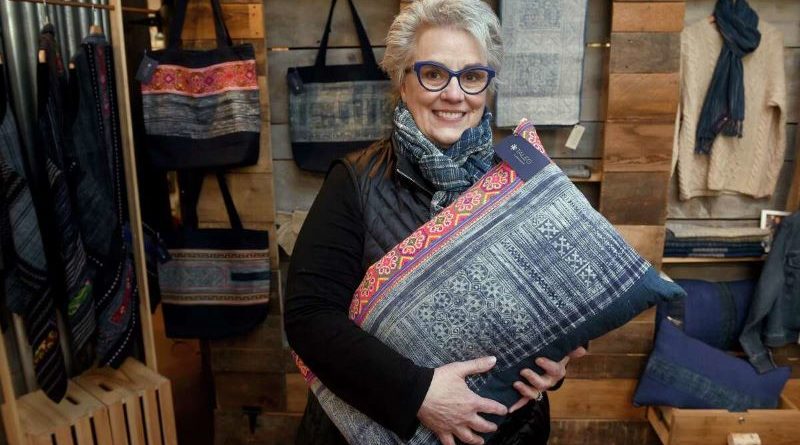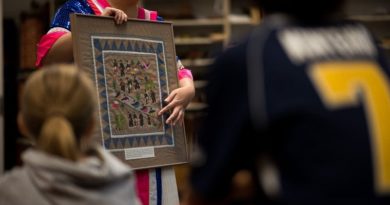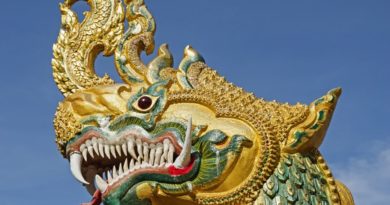U.S. Based Fiber Designer Brings Rare Indigo Made in Laos to Branford’s BACA Gallery
Source: CT Insider
Sally Strasser is true blue in her obsession with rare, natural indigo textiles she discovered on a trip to Laos. And she is eager to share her passion with others. Through her new venture, Taleo, Strasser turns handmade fabrics, made using ancient techniques, into decorative pillows, scarves, vests, colorful tote bags, and table runners.
The Branford resident says she is “trying to be a missionary” by bringing these unique pieces to the BACA Gallery in Branford, from remote villages in Southeast Asia. The denim-colored cloth has a familiar look — kind of like a worn pair of blue jeans. That is until a visitor takes a closer look and learns more.
Strasser’s hope is to support the makers, who are “subsistence rice farmers,” helping them supplement their income “by their handicrafts.”
The self-described “textile person” began her love affair with fabric as a girl. “I have loved textiles as long as I can remember. I’ve loved fabric, sewing, design, going back to my childhood in a little town in Indiana,” she said. There, most of her friends were Mennonite and many had living Amish grandparents who passed down a “very strong sewing tradition.”
“The mothers would make my friend’s clothes,” she recalled.

Little did she know that many years later, a “fluke” trip to Southeast Asia would lead her to create Taleo. Her daughter who was teaching English in China invited Strasser to visit during the Chinese New Year. During their mother-daughter trip, “We just kind of picked Laos.”
When visiting tiny rural villages, she was thrilled to see that “every house was a bamboo house on stilts with a loom underneath it, And women were spinning cotton and doing natural dying and weaving.” It amazed her: “I knew what I was seeing because of my history and historic textiles, but I couldn’t believe what I was seeing.” She thought their methods “had died out hundreds of years ago.”
“And here were women doing these things — ancient, ancient, textile traditions for themselves. This was not for tourists. This was not for display like you would see reenacting at Colonial Williamsburg,” she said.
“They were growing cotton. spinning cotton, growing indigo to dye the cotton, weaving the cloth, making the clothes,” she said. “This is field to fiber like farm to table.”
“I was just so gobsmacked, really, that I had stumbled on this unknowingly. And I just couldn’t just get it out of my mind,” she remembered.
She bought as much as she could fit in her luggage for the trip back home. “The best thing I can do is buy their products, even if I have no idea what I’m going to do with them,” she said. “And maybe they can keep going.”
After her daughter completed her stint in China, she got a grant to do public health work in Laos.
This was like a dream come true for mom, who was eager to go back. She brought along an extra empty suitcase. “But this time I’m going to buy more and take them home and see if I can sell them to friends,” she recalled.
Strasser also showcases textiles from the Hmong ethnic group in northern Laos. She re-purposes a colorful, traditional baby carrier into a decorative pillow for the home. And that’s not all. She also buys clothing from the Hmong who dispose of their old clothes for the New Year, a tradition “like a cleansing ritual.”
The Hmong “have to have new clothes for the New Year, head to toe,” she said, noting they follow the lunar calendar like the Chinese. Previously, the Hmong would burn their old clothes but “now they know that people value them, so they’re willing to sell them.”
“So the women are valued for their work and they get a fair wage for their pieces.” The villagers live simply, using the money for “buying minutes for their cell phones and fuel for their motorbike.”
The Hmong women also use natural indigo dye, but make exceptionally intricate designs on fabric with beeswax they “foraged from the forest.”
For the Batik, beeswax is heated in “a little bowl over some coals.” Using a stylus, the artist draws a design with melted wax. Once the wax cools, the item is dyed. After it sets, the cloth is boiled to remove the wax.
Imperfections, “these little blips” seen extremely close up “can show you that it’s hand-drawn,” not mass produced, she explained. Then they add “exquisite embroidery” in vivid colors or indigo, done freehand.
Modern cross-stitchers, on the other hand, often use patterns with a “precise grid that’s easy to follow,” Strasser noted.
For the Hmong, “There’s no grid, their counting…it’s perfect. The reverse side is as perfect as the front,” she said, with evident admiration.
On her trips, Strasser wants to help the women any way she can: “I take glasses when I go, I take tons of readers and I pass them out” to help them with their extremely close work.
Through Taleo she aims to protect “women’s roles in communities” and “textile traditions and sustainability,” Strauss said.
“So I think of myself as protecting those things. So it’s a symbol of protection,” she said about the name of her small business.




